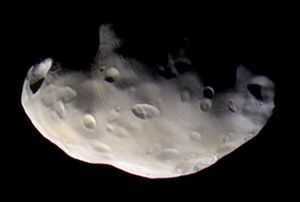Pandora (moon)
|
Pandora, as imaged by Cassini | |
| Discovery | |
|---|---|
| Discovered by | Collins, Voyager 1 |
| Discovery date | October, 1980 |
| Orbital characteristics [1] | |
| Epoch December 31, 2003 (JD 2453005.5) | |
| 141720±10 km | |
| Eccentricity | 0.0042 |
| 0.628504213 d | |
| Inclination | 0.050°±0.004° to Saturn's equator |
| Satellite of | Saturn |
| Physical characteristics | |
| Dimensions | 104 × 81 × 64 km [2] |
Mean radius | 40.7±1.5 km [2] |
| Volume | ≈ 280000 km3 |
| Mass | (1.371±0.019)×1017 kg[2] |
Mean density | 0.49±0.06 g/cm³[2] |
| 0.0026–0.0060 m/s² [2] | |
| ≈ 0.019 km/s | |
| synchronous | |
| zero | |
| Albedo | 0.6 |
| Temperature | ≈ 78 K |
|
| |
Pandora (/pænˈdɔərə/ pan-DOHR-ə; Greek: Πανδώρα) is an inner satellite of Saturn. It was discovered in 1980 from photos taken by the Voyager 1 probe, and was provisionally designated S/1980 S 26.[3] In late 1985 it was officially named after Pandora from Greek mythology.[4] It is also designated as Saturn XVII.[5]
Pandora was thought to be an outer shepherd satellite of the F Ring. However, recent studies indicate that it does not play such a role, and that only Prometheus, the inner shepherd, contributes to the confinement of the narrow ring.[6][7] It is more heavily cratered than nearby Prometheus, and has at least two large craters 30 kilometres (19 mi) in diameter. The majority of craters on Pandora are shallow as a result of being filled with debris. Ridges and grooves are also present on moon's surface.[8]
The orbit of Pandora appears to be chaotic, as a consequence of a series of four 118:121 mean-motion resonances with Prometheus.[9] The most appreciable changes in their orbits occur approximately every 6.2 years,[1] when the periapsis of Pandora lines up with the apoapsis of Prometheus and the moons approach to within about 1,400 kilometres (870 mi). Pandora also has a 3:2 mean-motion resonance with Mimas.[1]
From its very low density and relatively high albedo, it seems likely that Pandora is a very porous icy body. There is a lot of uncertainty in these values, however, so this remains to be confirmed.
Gallery
-

Voyager 2 image of Pandora (August 1981).
-

Pandora as seen from the Cassini probe in 2005; the rings of Saturn are in the background.
-
_PIA_12690.png)
Cassini captured this close view of Saturn's moon Pandora during the spacecraft's flyby on June 3, 2010.
References
Citations
- ↑ 1.0 1.1 1.2 Spitale Jacobson et al. 2006.
- ↑ 2.0 2.1 2.2 2.3 2.4 Thomas 2010.
- ↑ IAUC 3532.
- ↑ IAUC 4157.
- ↑ USGS: Planet and Satellite Names and Discoverers.
- ↑ Lakdawalla, E. (2014-07-05). "On the masses and motions of mini-moons: Pandora's not a "shepherd," but Prometheus still is". Planetary Society. Retrieved 2015-04-17.
- ↑ Cuzzi, J. N.; Whizin, A. D.; Hogan, R. C.; Dobrovolskis, A. R.; Dones, L.; Showalter, M. R.; Colwell, J. E.; Scargle, J. D. (April 2014). "Saturn’s F Ring core: Calm in the midst of chaos". Icarus 232: 157–175. doi:10.1016/j.icarus.2013.12.027. ISSN 0019-1035.
- ↑ Solar System, NASA: Pandora.
- ↑ Renner et al. 2005.
Sources
- Marsden, Brian G. (October 31, 1980). "Satellites of Saturn" (DISCOVERY). IAU Circular 3532. Retrieved 2011-12-29.
- Marsden, Brian G. (January 3, 1986). "Satellites of Saturn and Pluto" (NAMING THE MOON). IAU Circular 4157. Retrieved 2011-12-29.
- Renner, Stéfan F.; Sicardy, Bruno; French, Richard G. (March 2005). "Prometheus and Pandora: Masses and orbital positions during the Cassini tour". Icarus 174 (1): 230–240. Bibcode:2005Icar..174..230R. doi:10.1016/j.icarus.2004.09.005.
- "Saturn: Moons: Pandora". Solar System Exploration: Planets. NASA. 4 Apr 2011. Retrieved 2011-12-29.
- Spitale, J. N.; Jacobson, R. A.; Porco, C. C.; Owen, W. M., Jr. (2006). "The orbits of Saturn's small satellites derived from combined historic and Cassini imaging observations" (PDF). The Astronomical Journal 132 (2): 692–710. Bibcode:2006AJ....132..692S. doi:10.1086/505206.
- Thomas, P. C. (July 2010). "Sizes, shapes, and derived properties of the saturnian satellites after the Cassini nominal mission" (PDF). Icarus 208 (1): 395–401. Bibcode:2010Icar..208..395T. doi:10.1016/j.icarus.2010.01.025.
- USGS/IAU (July 21, 2006). "Planet and Satellite Names and Discoverers". Gazetteer of Planetary Nomenclature. USGS Astrogeology. Retrieved 2011-12-29.
External links
| Wikimedia Commons has media related to Pandora (moon). |
| ||||||||||||||||||||||||||||||||||||||||||||||
